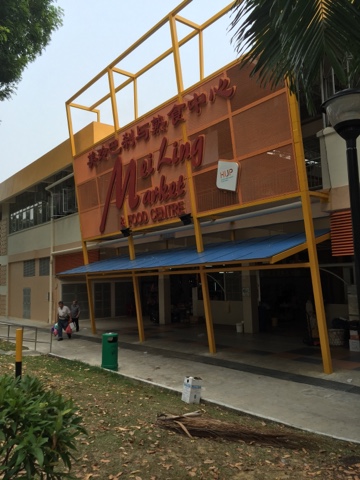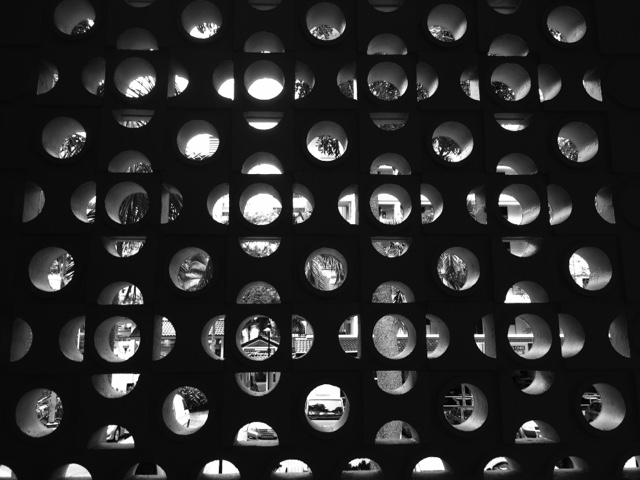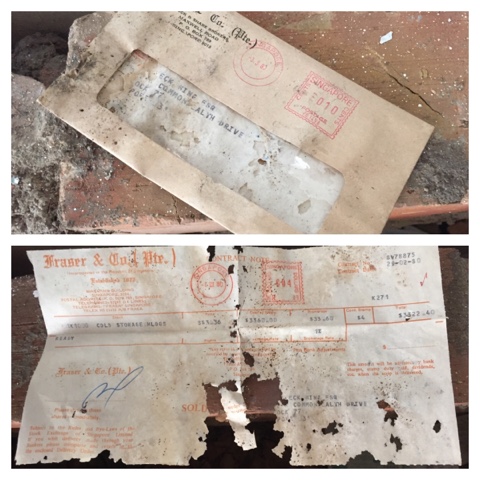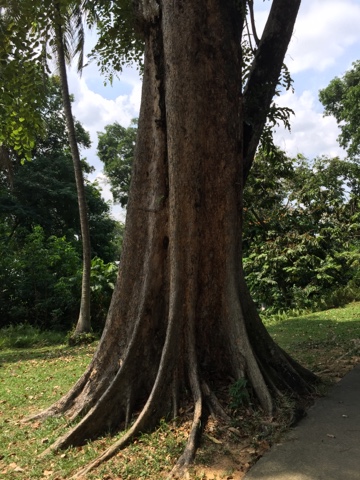 |
| Welcome to Coney Island |
The island was bought over by the Haw Par brothers - Aw Boon Haw and Aw Boon Par, who built a beach villa on the island. (22) "The 600 sq m building is the only
known villa remaining from the Aw family. It has a central hall and
an open verandah that surrounds the house. A separate single-storey 100
sq m house was a service block. Its architect was likely to be Ho Kwong Yew, a leading architect of the Modern Movement in Singapore during the 1930s."(23)
1937
A tender was published in the newspaper seeking for companies to bid for the erection of a bangalow on Haw Par Island (Pulo Serangoon). (29)
1947
The villa fell into disrepair during the Japanese Occupation and a auction notice was placed in the newspaper for the sale of the island and its building. (22) (25) (30)
1950
Previously named Haw Par Island, Indian businessman Ghulam Mahmood bought over the island from Mr Aw Boon Haw and called it "Singapore's Coney Island". He had planned to spend $100,000 to turn it into a resort. The resort would include a dance hall, bar and restaurant. (24) (25)
1951
 |
| Advertisement in the newspaper (27) |
The owner did try to get the resort off the ground. There was a launch every 1/2 hour and arriving on the island, visitors would be entertained by singers and also, the Coney Island Band. (26) (27)
1955
"Pleasure isle for sale" - headlined a 1955 The Straits Times article. It was said that the owner, Mr Tarlok Singh, had intended to sell this 32-acre island (12.8 hectares) located off Punggol. At that point of sale, there was "a building with a dance floor and several seaside cabins." The island also had its own electric power plant. (1) By then, the island was already deserted. (28) Though Singaporeans would head to the island for picnics, the idea of having a Coney Island similar to what was in New York failed to take off.
1971
In 1971, it was said that a Thai owner of Coney island was looking to sell off the freehold island for S$1 million. By then, the island was already a hot spot for swimming and water-skiing. Visitors could visit the island by taking a 30-minute boat ride via the Punggol Jetty. The article had also mentioned that there were remains of old army barracks. Hmm, so who built those army barracks? (2)
In the same year, there were talks about damming the sea to build a mega reservoir so as to meet Singapore's growing water needs. (3) The damming of the sea did not happen, but a more palatable damming of the river - Sungei Serangoon was completed in 2011 - 40 years after the idea of such a reservoir was first discussed. (4) Sungei Serangoon has an entire history on its own which I plan to cover in another post.
1972
Port of Singapore Authority (PSA) then purchased the island in 1972 and laid out its plan of wanting to develop the island into a recreational resort. The statutory board had also hoped to expand the island through a S$14.5 million reclamation work that started in March 1974. (5) With this reclamation, the plan was to increase the size of the island to 154 acres (54 hectares). (6) (7) It is said that the island would be linked by a bridge to the mainland. (8)
1976
Alas, it was not all about white sandy beaches. In 1976, the island had faced with issues such as pollution from the pig farms in Punggol that had afflicted the island till the late 80s. (9) (10) Oil-slick waters was also a perennial issue. (9)
1982
In 1982, the complaint was about a pack of mongrels that were left on the island by owners to fend for themselves. (11)
1987
In 1987, PSA released the rights of the island to Singapore Housing Development Board. The plan was to reclaim the Punggol foreshore and with that, the island will be joined to the mainland. (12)
1994
In 1994, boatman Lu Song Fa opined that Coney Island has remained pretty much the same as it was decades ago. He was the only boatman operating the service to Coney Island. At one time, there were as many as 14 boats that took visitors to the island. These were beach goers and anglers. (14) The water off the island was also good for water-skiing.
1995
More concrete plans for the island came about in 1995 when the Urban Redevelopment Authority (URA) talked about land reclamation of the island. The plan was similar to the previous suggestion of land reclamation. However, there would be a river that separates Punggol and Coney Island. There were further plans of building either private or public housing on both banks. (13)
2008
Work on the island started in earnest in 2008. The decision was to build a coastal promenade and also a rustic park. (15)
2012
The final decision, lauded as a victory for nature lovers, was made by NParks to turn into Singapore's ninth nature park. (16) Nature lovers have been calling for the island to be preserved in its natural state as migratory birds such as the blue-throated bee-eater and jerdon's baza would usually make this little island their temporary home. (18) However, this is only the immediate plans as suggested by NParks. In the future, it is said that there will also be other developments, other than it just being a nature park. This will include a housing estate on the island itself. (17) (19)
2015
The 50ha island was officially opened by Coordinating Minister for Infrastructure, Mr Khaw Boon Wan on October 10, 2015. There are five beaches and two bridges that are linked to the eastern and western ends of Punggol Promenade and Pasir Ris Coast Industrial Park 6. The park is opened from 7am to 7pm. (20)
The park cost S$3million and took a total of 15 months to complete. There's a 2km stretch of shoreline and 2.4km path that stretches from the eastern to western bridge. Interestingly, there is no electricity or piped water on the island. So in comes solar power and harvested rain water. (22)
References:
1. Pleasure isle for sale. September 8, 1955. The Straits Times. P5.
2. It's yours if you have a million to spare. August 31, 1971. New Nation. P1.
3. Water. August 31, 1971. New Nation. P1.
4. PUB. Local Catchment Water. Accessed on November 11, 2015. http://www.pub.gov.sg/water/Pages/LocalCatchment.aspx
5. Reclamation of foreshore. March 9, 1974. The Straits Times. P22.
6. Pulau Coney di-beli oleh pehak PSA. November 21, 1972. Berita Harian. P10.
7. Big Coney Isle Plan. January 4, 1974. New Nation. P3.
8. Beach of the future. September 11, 1974. New Nation. P3.
9. PSA plan for resort islands hit by pollution. December 25, 1976. The Straits Times. P6.
10. De Silva, G. July 29, 1989. Keep Pulau Seletar as it is - a 'hideaway' island. The Straits Times.
11. Unwanted dogs left to starve on the island. November 10, 1982. The Straits Times. P12.
12. Coney Island to be swallowed up. April 16, 1987. The Straits Times. P13.
13. Low, M. November 8, 1995. URA to sell Changi land for resort use, reclaim 110ha off Punggol. The Straits Times.
14. Tan, W. June 23, 1998. A last look at Coney Island. The Straits Times.
15. Development plan takes shape in Punggol. May 17, 2008. Channel News Asia.
16.Toh, K. February 19, 2012. Coney island set to become nature park. The Straits Times.
17. Nature park amid various projects. February 26, 2012. The Straits Times.
18. Rustic nature park for Coney Island. November 20, 2012. The Straits Times.
19. Wild greenery makes S'pore a global eco-city. May 1, 2013. The Straits Times.
20. Coney Island Park, Singapore's new nature destination, now open. October 10, 2015. The Straits Times.
21. New nature park opens on Coney Island. October 10, 2015. Channel News Asia.
22. Coney Island Park opens to the public. October 11, 2015. The Straits Times.
23. Coney Island: A walk on the wild side. October 17, 2015. The Straits Times.
24. 'Coney Island' ready by the end of this year. August 11, 1950. The Singapore Free Press. P5.
25. Coney Island for S'pore. April 4, 1950. The Straits Times. P7.
26. Advertisement. April 26, 1951. The Singapore Free Press. P11.
27. Advertisement. March 21, 1951. The Singapore Free Press. P7.
28. She saved marooned monkey. February 20, 1955. The Straits Times. P5.
29. Advertisement. February 1, 1937. The Straits Times. P2.
30. Advertisements. July 9, 1947. The Straits Times. P2.












































